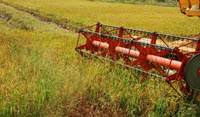 Visit our offices on any given day, and you are likely to discover researchers putting mass spectrometry to the test. The hum of the mass spectrometer is as common as conversations as scientists are tasked with developing methods that can be applied in real-world lab scenarios. In this case, André Schreiber SCIEX, Concord, Ontario, Canada, detailed, Comprehensive Quantitation and Identification of Pesticides in Food Samples Using the SCIEX UltraLC 100* and the SCIEX QTRAP® 4500 System. Applying a combination of LC-MS/MS technology, Schreiber demonstrates how it is possible to detect hundreds of pesticides and other food residues in a single run as demands in the food testing industry to detect and quantify an increasing number of compounds in a single run become more prevalent.
Visit our offices on any given day, and you are likely to discover researchers putting mass spectrometry to the test. The hum of the mass spectrometer is as common as conversations as scientists are tasked with developing methods that can be applied in real-world lab scenarios. In this case, André Schreiber SCIEX, Concord, Ontario, Canada, detailed, Comprehensive Quantitation and Identification of Pesticides in Food Samples Using the SCIEX UltraLC 100* and the SCIEX QTRAP® 4500 System. Applying a combination of LC-MS/MS technology, Schreiber demonstrates how it is possible to detect hundreds of pesticides and other food residues in a single run as demands in the food testing industry to detect and quantify an increasing number of compounds in a single run become more prevalent.
Liquid Chromatography coupled to Tandem Mass Spectrometry (LC-MS/MS) is a widely used analytical tool for the screening of food residues and contaminants. This technical note presents a new method using QuEChERS extraction, separation using the UltraLC 100 system with a Phenomenex Synergi™ 2.5u FusionRP column, and the SCIEX QTRAP 4500 System. The mass spectrometer was operated in highly selective and sensitive Multiple Reaction Monitoring (MRM) mode. The Scheduled MRM™ algorithm was used to obtain the best data quality and combined with fast polarity switching to cover the broadest range of pesticides possible. Also, MS/MS spectra were acquired to enable compound identification with the highest confidence based on mass spectral library matching.
Download the eBook to see full LC-MS/MS method details utilizing the UltraLC 100 and the QTRAP 4500 System using the Scheduled MRM algorithm in combination with fast polarity switching, and acquisition of MS/MS spectra for compound identification.
Pesticides—The Good and Bad
Farmers aim to apply an appropriate level of pesticides with acceptable residuals and do so discriminately as government and manufacturers of pesticides educate them as to how to minimize their use. However, “sometimes farmers add too much, which does leave a residue,” said Phil Taylor Global Marketing Manager, Food, Environmental, and Forensics. “Therefore, we test for remnants even though during harvest, farmers wash the fruit and vegetables.”
Should the general consumer be worried about getting sick from consuming fruit and vegetables as some studies have indicated that health problems can arise with long-term ingestion of high levels of pesticides? The answer depends. World governments have placed Maximum Residue Limits (MRLs) on pesticides in fruits and vegetables. Food testing labs, and perhaps you are one of them, are thus charged with testing foods to ensure that fruits with levels higher than the MRLs do not make it to your table. The safest way to avoid such problems said Taylor, “is to eat organic foods or wash your fruits and vegetables thoroughly whenever possible before eating or cooking them.”
*Looking for an HPLC or UHPLC system? Learn more about the ExionLC Series >






 Contact Support
Contact Support
0 Comments